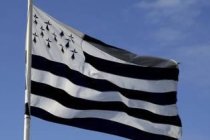Brest

Brest is a port city in the Finistère (Breton: Penn-ar-Bed) département in Brittany. Its history, at least since the 17th century been linked to the sea. Brest continues to be an important harbour and the military port and every four years it hosts the international festival of the sea, boats and sailors. It is the third largest metropolitan area in Brittany (with a population of 300,300 in total), ranking third behind only Nantes (Breton: Naoned) and Rennes (Breton: Roazhon). Brest is also an important university town with 23,000 students.
The name of the town is first recorded as Bresta; which is thought to derive from brigs, a Celtic word for hill. Brest was heavily bombed by the Allies during World War II; in an attempt to destroy the submarine base the Germans had built in the harbour. As a result the city does not have much remaining historical architecture. There are some remaining monuments, including the castle and the Tour Tanguy a medieval tower thought to date to the 14 century, although much altered over the years. It contains a museum of the history of Brest.
Also in the city is the Château de Brest, a castle that is oldest monument in Brest. The first fort of which evidence remains is from the Roman era. Over the centuries it has been renovated and altered a number of times. The Musée national de la Marine (National Navy Museum) is now also located in the castle. The site on which the castle stands was inhabited during the Lower Palaeolithic (300,000 BC) and in the Neolithic agricultural activity took place. Given its strategic position there is also a supposition that the site could have held a prehistoric fortification.
Image: The Outer Harbor of Brest painting 1773 by Henri-Joseph Van Blarenberghe (1741-1826).
Link: Brittany Tourism and Office de tourisme de Brest métropole - Bretagne
Celtic nation:
- Brittany
Itinerary:
- Brittany south
Place type:
- Village/Town/City





